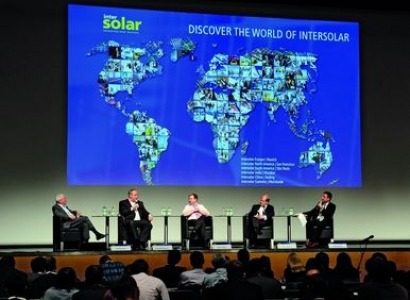
Worldwide PV module capacity grew by an average of 44 percent each year between 2000 and 2013, according to the current Photovoltaics Report published by Fraunhofer Institute for Solar Energy Systems.
Analysts expect a further 55 GW to be added in 2015, which would correspond to an increase of 20 percent from the 46 GW recorded in 2014. This growth is partly attributed to ongoing technological advances in photovoltaics, which have continuously improved solar cell and module efficiency, while better production technologies have reduced material consumption. Technology and economies of scale also caused prices to drop rapidly.
With solar energy continuing to expand, the industry is faced with a number of questions, such as how technological innovations can be used to optimize on-site consumption, how grids can be designed to accommodate for the growing share of solar energy and how energy can be stored efficiently and economically.
These questions and many more will be addressed by international experts from research, industry and associations at this year’s conference.
Global Market Developments
For businesses to be successful, they require knowledge of the various international photovoltaics markets and their different political, economic and legal conditions. Currently, more than half of the world’s photovoltaics capacity is installed in Europe, where a steady annual growth of 10 GW is expected over the next few years. Growth rates are considerably higher in markets like China, the USA and Japan, however.
During several sessions at the Intersolar Europe Conference, experts will take a detailed look at the markets in Europe, Asia, North and South America, the Middle East and Africa, as well as their political, legal and financial conditions.
Focus On Innovations
Technological innovations form a further area of interest at the events, where speakers will showcase the latest developments from solar cell and module manufacturers, and highlight advances in current inverter technologies taking into account the increasingly complex nature of PV installations, for example.
Other topics include global trends in PV power plants and matters surrounding PV installations, particularly hybrid systems created from combined solar and diesel installations.
Financing Trends
In Europe, the era of feed-in tariffs is drawing to a close, making new financing models more important than ever and an essential component of new business models. Several presentations shed light on current trends in financing and managing solar installations, focusing in particular on new forms of financial cooperation between local energy suppliers, project developers and financial service providers.
Smart Future
To accommodate for the continuously growing share of solar energy in the energy mix, intelligent solutions for both the energy supply infrastructure and the consumer are required. Energy management systems can be used to control the flow and consumption of electricity in households while keeping costs to a minimum and conserving as much energy as possible.
During presentations, speakers will provide information on designing smart grids and decentralized energy storage systems in addition to solutions for smart homes. Representatives of local energy suppliers, grid operators and service providers will also be present to discuss plans to develop city infrastructure to create smart cities.
Focus On The Energy Storage Growth Market
Energy storage systems are playing an increasingly important role in the energy transition’s success. Taking place at the same time as the Intersolar Europe Conference, this year’s EES Europe Conference is dedicated to energy storage issues, including different storage markets, technologies and production technologies, battery safety and security and recycling.
For additional information:

